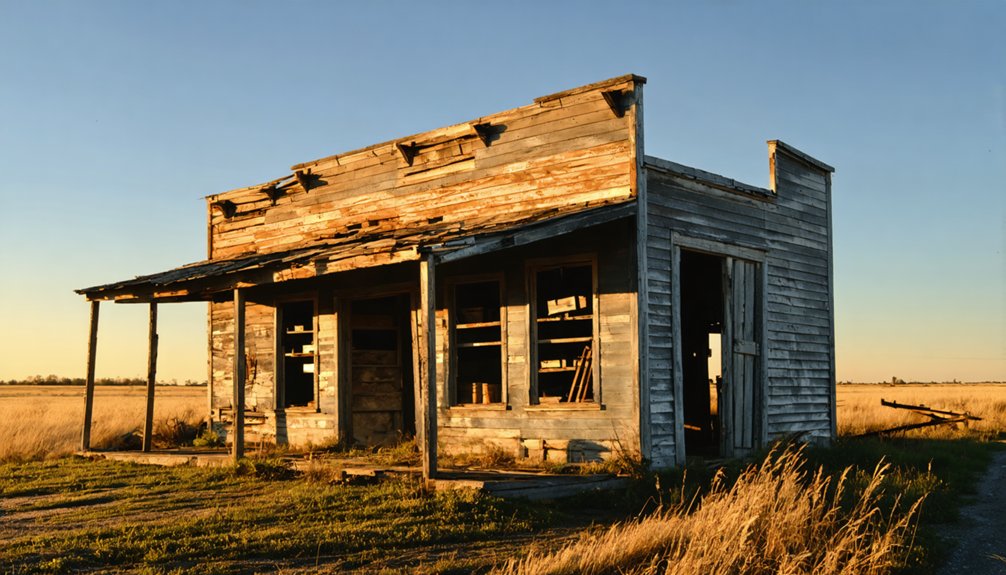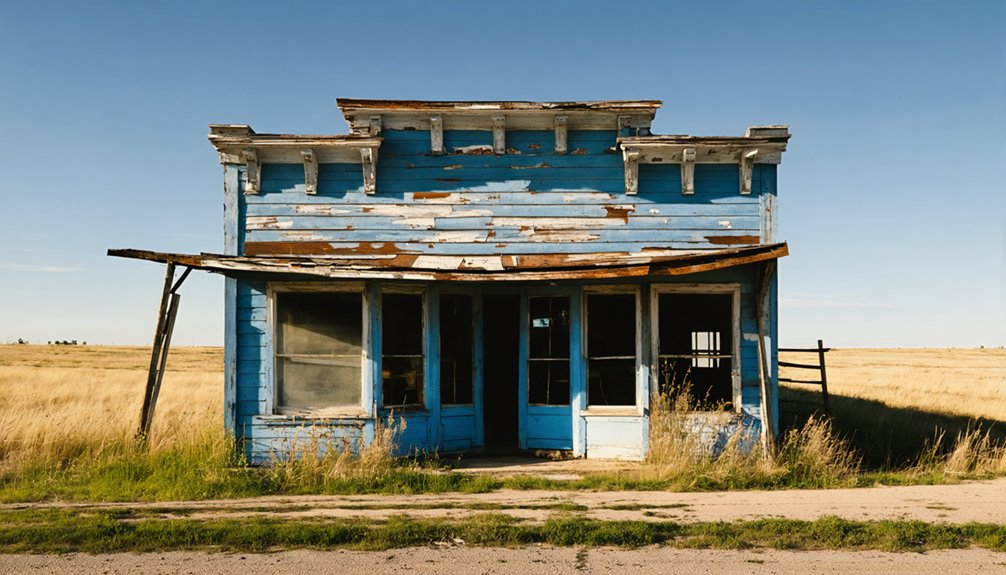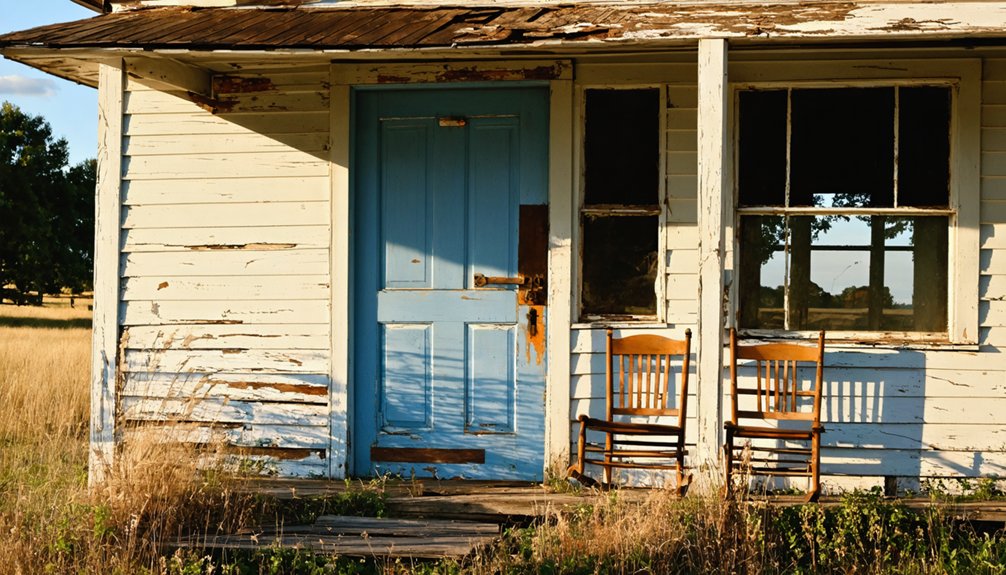You’ll find Harney’s ghost town ruins tucked within the Black Hills’ ponderosa forests near modern-day Hill City, South Dakota. This 1870s mining settlement boomed after the discovery of gold and tin deposits, attracting thousands of prospectors who defied the Fort Laramie Treaty with the Sioux. While British investors poured over $2 million into the area’s mining operations, economic struggles eventually led to abandonment. Today, preserved foundations and mining remnants tell a compelling story of western expansion’s dramatic rise and fall.
Key Takeaways
- Harney was established during the 1870s Black Hills gold rush, later transitioning to tin mining before becoming a ghost town.
- The town flourished briefly due to the Harney Peak Hydraulic Gold Mining Company and Harney Peak Tin Mining Company operations.
- British and American investors poured $2 million into mining claims covering 5,000 acres before economic challenges led to abandonment.
- Today, visitors can explore historic foundations and ruins near Hill City, surrounded by the Black Hills’ ponderosa forests.
- The ghost town serves as an open-air museum, preserving artifacts and structures from the region’s 19th-century mining boom.
The Birth of a Black Hills Mining Camp
While the Black Hills gold rush attracted thousands of prospectors in the 1870s, it was the discovery by Fred and Moses Manuel, Hank Harney, and Alex Engh that transformed the region’s mining landscape. Their identification of hard-rock gold deposits near modern-day Lead sparked a shift from basic placer mining techniques to more sophisticated extraction methods. Placer gold deposits were first discovered in the region’s creeks and streams, drawing early prospectors.
You’ll find that early mining camps, including Harney, quickly emerged as vibrant communities supporting this gold fever. The social dynamics of these settlements revolved around essential infrastructure – from whim houses and boarding facilities to blacksmith shops and 24-horse stables. Under the leadership of Colonel James Clark, mining operations expanded significantly throughout Pennington County by 1904.
As miners traded their gold pans for dynamite and drilling equipment, camps expanded to accommodate complex ore processing operations. The Homestake claim‘s free-milling ore proved especially valuable, drawing experienced miners and investors who’d shape the Black Hills’ mining destiny.
Gold Rush Fever and Early Settlement
After Lt. Col. George Armstrong Custer’s 1874 discovery of gold in French Creek, you’d have witnessed an unprecedented rush of miners flooding into the Black Hills, defying the Fort Laramie Treaty with the Sioux.
Settlement patterns emerged rapidly as prospectors first worked placer deposits in creek beds before evolving to hard rock mining. The Kiowa and Crow tribes had originally inhabited these lands before the rush began.
Early miners followed creek beds for placer gold before digging deeper into the Hills’ hard rock deposits.
You’ll find Harney’s influence throughout the region, particularly in the monumental Homestake discovery he made with the Manuel brothers and Alex Engh in 1876. This find, yielding over 40 million ounces of gold, transformed the area’s destiny. San Francisco investors led by George Hearst purchased the operation for $70,000.
While many mining camps appeared and vanished, some like Crossville, founded in 1877 near Buckeye Gulch, established permanent roots.
The rush brought dramatic changes, from hydraulic mining operations to the arrival of East Coast investors, forever altering the Black Hills’ landscape.
From Boom to Bust: Mining Operations
During the peak of Harney’s mining era, you’d have found a bustling landscape dominated by the Harney Peak Hydraulic Gold Mining Company and the Harney Peak Tin Mining Company.
Innovative mining techniques transformed the region as elaborate flumes and sluices carved through the Black Hills terrain, while prospectors chased dreams of striking it rich.
The discovery of tin in 1883 sparked a dramatic shift in operations, with Dr. S.H. Ferguson’s Etta Mine leading the charge. The mine struggled financially and entered into receivership in 1886.
You’d have witnessed British and American investors pouring over $2 million into claims covering 5,000 acres.
Fred Cross’s cabin in Buckeye Gulch marked the first permanent settlement in the area in 1877.
However, economic fluctuations and the harsh reality of low-grade ore soon took their toll.
Despite substantial investments in equipment and infrastructure, the mines couldn’t sustain profitability, ultimately leading to the town’s abandonment and its current ghost town status.
Daily Life in a Mining Community
If you’d lived in Harney during its mining heyday, you’d have faced long days of physical labor using hydraulic mining equipment and mercury amalgamation processes to extract precious metals.
Your housing options would have ranged from basic cabins to small company-built structures, typically situated close to the mining operations where you worked. The town’s first settler, Fred J. Cross, established the initial housing pattern when he built his cabin in Buckeye Gulch in 1877.
After grueling shifts, you could have found community at the town’s simple establishments like general stores and saloons, which served as both practical necessities and social gathering spaces for the largely male workforce.
Work and Mining Routines
Mining life in Harney revolved around the demanding rhythms of underground and surface operations, where workers navigated complex shifts in gold, tin, and mica extraction.
You’d find yourself working long hours alongside specialized crews – from equipment operators to mill workers – each with their defined responsibilities in the intricate mining process.
Daily routines centered on physically demanding tasks in dark, cramped conditions. You’d handle heavy mining equipment while coordinating with timber crews who supplied essential infrastructure support. The mine’s depths eventually reached an impressive 8,000 feet deep, requiring workers to descend further into the earth’s crust. The introduction of chlorination and smelting by 1890 revolutionized how miners processed difficult-to-extract gold ore.
When labor disputes arose over mineral rights or land claims, you’d still receive steady wages, which mining companies used to maintain their workforce.
Water management became a fundamental part of your day, especially during hydraulic mining operations that required extensive flume systems spanning hundreds of feet across the landscape.
Social Gathering Places
Life in Harney centered around vibrant social hubs that served as the heartbeat of this mining community.
You’d find various social venues that fostered community cohesion, creating bonds among miners and their families. These gathering spots offered essential spaces for relaxation, connection, and mutual support in the challenging frontier environment. Like many of the six hundred ghost towns that once dotted the Black Hills region, Harney’s social spaces played a crucial role in daily life.
- The local saloon served as a primary meeting point where you could unwind after long shifts and exchange news.
- Storefront establishments extended credit and acted as informal financial centers.
- Churches provided spiritual guidance while doubling as community meeting spaces.
- The sawmill became a natural junction for coordinating work and sharing information.
- Company-sponsored facilities, including volunteer fire stations, strengthened communal ties through shared responsibilities.
Housing and Living Conditions
Three distinct types of housing dotted Harney’s rugged landscape during its mining heyday, from hastily constructed log cabins to company-built stone structures.
You’d find most miners living in basic timber dwellings, built quickly from local Black Hills lumber to combat the severe housing scarcity during population booms. Many newcomers started in tents or makeshift shacks until they could secure better miner accommodations.
Daily life in these homes wasn’t easy. You’d wake to the constant noise of mining operations, deal with dusty air, and rely on oil lamps for light.
The harsh mountain winters proved especially challenging, as most dwellings lacked proper insulation. When mines prospered, you might’ve added a porch or chimney, but during downturns, homes were often abandoned, leaving behind the ghost town structures you’ll see today.
The English Mining Company’s Influence
After the discovery of cassiterite at the Etta Mine, British and American investors formed the ambitious Harney Peak Tin Company, marking the beginning of significant English influence in South Dakota’s mining industry.
This bold venture of English investment and mining speculation transformed the local landscape with massive capital injections exceeding $2 million.
You’ll find these remarkable developments shaped the region:
- Construction of three reduction plants and acquisition of over 1,100 mining claims
- Formation of multiple companies, including the Harney Peak Consolidated Tin Company with $15 million in capital stock
- Coverage of more than 5,000 acres of mining territory
- Payment of competitive wages that shifted local focus from gold to tin mining
- Establishment of London stock exchange connections that drew international attention
Architecture and Infrastructure

When Harney first emerged in 1876, its architecture reflected the hasty nature of a gold rush settlement, with makeshift structures dotting the landscape.
You’d have found miners living in tents and crude log cabins as they sought their fortunes in the Black Hills.
The town’s architectural evolution took a significant turn during the tin boom of 1883.
You would’ve seen more permanent structures rising along Main Street, including the impressive Harney Peak Hotel and the mining company’s headquarters.
Infrastructure expanded to support the booming population, with a post office, roads, and essential services.
Natural Surroundings and Geography
You’ll find Harney nestled within the dense ponderosa forests of South Dakota’s Black Hills, where granite peaks and forested valleys create a dramatic landscape between Custer and Keystone.
The ghost town‘s surroundings include the imposing Black Elk Peak, which reaches 7,242 feet and holds deep spiritual significance for the Lakota people.
The region’s rugged terrain, shaped by ancient Precambrian granite formations, experiences harsh winters and mild summers typical of the Black Hills’ mountain climate.
Black Hills Forest Setting
The Black Hills‘ distinctive forest setting surrounds the ghost town of Harney with a dense canopy of ponderosa pine, creating an ecological island that rises dramatically from the surrounding Great Plains grasslands.
You’ll find yourself immersed in a rich forest ecology where perennial streams cut through the landscape, sustaining diverse wildlife and vegetation unique to this region.
- Black Elk Peak towers above at 7,242 feet, marking the highest point in this dome-shaped uplift
- Dense stands of ponderosa pine dominate the forest, mixed with aspen, oak, and endemic Black Hills spruce
- Natural meadows and open parks break up the forest canopy, especially in western areas
- Abundant rainfall supports numerous streams and creeks, including Spearfish and Rapid Creek
- Wildlife diversity flourishes with deer, mountain lions, and rare bird species like the three-toed woodpecker
Mountain Peaks and Valleys
Rising majestically above Harney’s remnants, Black Elk Peak anchors the surrounding landscape at 7,231 feet, marking South Dakota’s highest point among a collection of dramatic granite spires and formations.
You’ll find McGillicuddy’s Peak just 300 feet south of the main summit’s lookout tower, reaching nearly the same height at 7,229 feet.
The mountain ecology shifts dramatically from subalpine forests near the peaks to mixed-grass prairie in the valleys below.
These valleys, carved by ancient glaciers, now channel pristine creeks that feed the Cheyenne River Basin.
The geological formations surrounding you include the iconic Needles and Cathedral Spires – jagged granite monuments that the Lakota people know as Hiŋháŋ Káǧa.
From these heights, you can spot Sylvan Lake below and Mount Rushmore just 3.7 miles to the east-northeast.
Seasonal Weather Patterns
Despite its scenic Black Hills location, Harney’s weather patterns can shift dramatically across seasons, creating unique challenges for visitors and former residents alike.
The region’s diverse weather demands careful weather preparedness for seasonal activities throughout the year.
- Spring brings mild temperatures and lingering snow at higher elevations, ideal for hiking and wildlife viewing.
- Summer temperatures climb into the 80s with frequent afternoon thunderstorms, perfect for early morning exploration.
- Fall offers comfortable conditions with gradually cooling temperatures, making it prime time for photography.
- Winter delivers significant snowfall and below-zero temperatures, limiting accessibility.
- Weather can change rapidly at higher elevations like Harney Peak, so you’ll need to plan accordingly.
These distinct seasonal patterns shaped life in the historic mining town and continue to influence modern-day adventures in the area.
Notable Characters and Stories
Legends of Harney’s past interweave with broader Black Hills folklore, though distinct stories about the town itself remain elusive.
While local legends abound throughout the region’s 600+ ghost towns, Harney’s narrative blends into the larger mining folklore of neighboring Hill City, where the infamous “mile of Hell” hosted 15 raucous saloons during the tin boom.
The most significant historical figure connected to the area, General William S. Harney, left a controversial legacy. Known as “the Butcher” by the Lakota people following the 1855 Battle of Blue Waters, his name originally graced the region’s highest peak until its recent reclamation as Black Elk Peak.
The English investors behind the Harney Peak Tin Company shaped the area’s destiny, though their stories, like those of countless miners, have largely faded into time.
Preservation and Historical Significance

While Harney lacks formal archaeological protections, you’ll find this ghost town’s remnants reflect the broader preservation challenges faced throughout the Black Hills region.
You can explore the site’s historical significance as part of the area’s rich mining heritage, which saw over 600 similar settlements rise and fall during the late 19th century.
If you’re interested in heritage tourism, you should note that Harney’s minimal remaining structures serve as open-air exhibits of the region’s boom-and-bust mining era, though without organized preservation efforts or interpretive facilities.
Archaeological Protection Measures
Because of its historical significance within the Black Hills region, Harney’s archaeological sites receive protection under multiple federal laws, including the Antiquities Act of 1906 and the Archaeological Resource Protection Act of 1979.
These laws uphold archaeological ethics and preserve cultural heritage through strict regulations on excavation and research activities.
You’ll find these key protection measures in place:
- Mandatory consultation with Native American tribes for sites involving indigenous heritage
- Systematic documentation of artifacts, structures, and burial sites by the State Historical Society
- Implementation of stabilization techniques using traditional materials
- Restricted access pathways to prevent erosion and structural damage
- Coordination between federal agencies, state bodies, and private landowners for site management
The protection framework guarantees responsible preservation while maintaining respectful access to these historic treasures.
Heritage Tourism Development
Since its abandonment in the late 1800s, Harney has emerged as a significant heritage tourism site within the Black Hills’ network of ghost towns.
You’ll find carefully preserved foundations and ruins that tell the story of the region’s mining boom, while heritage trails connect you to both the town’s gold rush history and its complex relationship with Sioux culture.
Local historical societies have developed visitor engagement programs that respect both the physical remnants and cultural sensitivities of the area.
When you explore Harney, you’ll encounter interpretive signage that chronicles the town’s rise and fall, along with the broader narrative of Black Hills settlement.
The site offers you a unique opportunity to experience firsthand the dramatic story of western expansion, mining prosperity, and the profound cultural changes that shaped this landscape.
Exploring the Ghost Town Today
Today’s adventurous visitors to Harney ghost town must navigate forest service roads and hiking trails near Hill City in South Dakota’s Black Hills to explore this former tin mining settlement.
During your ghost town exploration, you’ll discover remnants of the area’s rich mining heritage near Black Elk Peak, the region’s highest point at 7,244 feet.
- Discover historic foundations and ruins of the once-bustling Harney Peak Tin Mining Company
- Trek past ash heaps and collapsed structures being reclaimed by nature
- View the 1938 Harney Peak Lookout Tower built by the Civilian Conservation Corps
- Experience panoramic vistas spanning four states from nearby summits
- Connect with the sacred Lakota landscape of Paha Sapa, where this historical site rests among the Cathedral Spires
Frequently Asked Questions
Are There Any Supernatural or Paranormal Stories Associated With Harney?
You won’t find documented ghost sightings or haunted legends specific to Harney itself, though the broader Black Hills region hosts numerous paranormal tales tied to its abandoned mining settlements.
What Happened to the Mining Equipment After the Town Was Abandoned?
You’ll find most of the mining equipment was either salvaged for scrap, sold to other operations, or abandoned to rust. Some pieces remain as historical significance markers, slowly decaying in the Black Hills.
How Safe Is It to Explore the Remaining Structures Today?
You’ll need to take serious safety precautions as the structural integrity of remaining buildings is questionable. Don’t explore alone, and watch for unstable floors, collapsing roofs, and hidden mine shafts.
Were There Any Major Crimes or Lawlessness During Harney’s Peak Period?
You won’t find documented crime statistics or significant law enforcement records from Harney’s peak period – unlike notorious Deadwood nearby, this small mining settlement doesn’t have verified reports of major lawlessness.
Did Any Famous Outlaws or Historical Figures Ever Visit Harney?
Like a ghost story without spirits, you won’t find famous visitors or outlaw legends here. While nearby Deadwood drew Wild Bill Hickok, there’s no evidence any notorious figures visited this mining settlement.
References
- https://blog.nativehope.org/reclaiming-sacred-sites-harney-peak
- https://www.sdhspress.com/journal/south-dakota-history-2-2/some-black-hills-ghost-towns-and-their-origins/vol-02-no-2-some-black-hills-ghost-towns-and-their-origins.pdf
- https://www.sdpb.org/rural-life-and-history/2023-08-21/some-black-hills-ghost-towns-and-their-origins
- https://www.blackhillsbadlands.com/blog/post/old-west-legends-mines-ghost-towns-route-reimagined/
- https://www.worldatlas.com/cities/this-is-south-dakota-s-quirkiest-little-town.html
- https://koa.com/campgrounds/hill-city/blog/the-history-of-hill-city-south-dakota_d2f2a510-44d2-4e37-80e2-e58db6751b04/
- https://en.wikipedia.org/wiki/List_of_ghost_towns_in_South_Dakota
- https://blackhillsvisitor.com/learn/etta-mine/
- https://holysmokeresort.com/the-history-of-holy-smoke-camp-resort-in-keystone-south-dakota/
- https://www.mininghistoryassociation.org/Meetings/BlackHills2018/Brief History of Gold Mining in the Black Hills page.pdf



